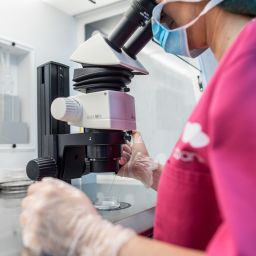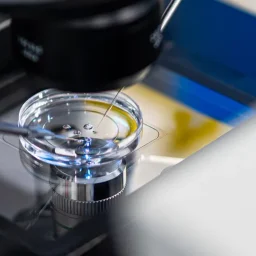
Since the 1990s, reproductive medicine has advanced significantly, incorporating techniques that are now standard in assisted reproduction laboratories. Among them, embryo biopsy and preimplantation genetic testing (PGT) are key tools to increase the chances of pregnancy and reduce genetic risks. Performing these techniques correctly and having specialized embryologists is essential to protect the health of the embryo and ensure reliable results (Cimadomo et al., 2016).
What is embryo biopsy and what is it for?
Embryo biopsy consists of extracting one or more cells from the embryo to analyze them genetically before transferring it to the uterus. This makes it possible to identify embryos free of chromosomal abnormalities or genetic mutations, reducing the risk of miscarriage or hereditary diseases.
It is mainly recommended in:
- Women over 35 years old, since the risk of chromosomal abnormalities increases with age.
- Couples with a history of recurrent miscarriages.
- Couples with male factors that may affect the embryo’s genetics (Fernandes et al., 2024).
Important: Not all patients need PGT; its indication depends on specific clinical and genetic criteria.
Embryo biopsy methods
There are three main methods: mechanical, chemical, and laser.
- Laser: Nowadays it is the most widely used, as it allows the incision to be made with great precision, speed, and safety, avoiding damage to the embryo’s cells (Mao et al., 2024).
- Mechanical: Involves physical manipulation of the embryo and is less precise.
- Chemical: Uses substances that can be harmful if not handled correctly.
The size of the opening is crucial: an incision that is too small may cause blastocyst herniation, while one that is too large may affect embryo viability. This highlights the importance of having experienced embryologists (Alteri et al., 2023).
When is the biopsy performed?
The embryo develops from the zygote to the blastocyst (day 5–6), at which point it has more cells and the trophectoderm and inner cell mass can be distinguished.
- Early stages (4–8 cells): May compromise viability and provide less representative results.
- Blastocyst (trophectoderm): Allows several cells to be extracted without affecting embryo development and provides more reliable results in genetic analysis (Bacal et al., 2025).
Recent research indicates that trophectoderm biopsy does not reduce implantation or increase obstetric or neonatal risks if performed correctly (Mao et al., 2024; Alteri et al., 2023).
Preimplantation Genetic Testing (PGT)
After the biopsy, the cells are analyzed using PGT to detect chromosomal abnormalities or mutations.
Main benefits of PGT
- Increases the chances of a successful pregnancy.
- Reduces the likelihood of miscarriage.
- Optimizes time and resources in assisted reproduction treatments (Fernandes et al., 2024; Cimadomo et al., 2016)
Remember: PGT is highly reliable, but it does not guarantee 100% that the embryo is free of abnormalities due to possible cellular mosaicism.
Conclusion
Embryo biopsy, combined with PGT, is a fundamental tool for couples with reproductive difficulties or genetic risk. It allows for the selection of healthy embryos, increases the chances of successful implantation, and offers greater safety for the patient and her future baby (Alteri et al., 2023; Mao et al., 2024).
References
- Cimadomo, D., et al. (2016). The impact of biopsy on human embryo developmental potential. Human Reproduction, 31(5), 1063–1072. https://doi.org/10.1093/humrep/dew038
- Mao, D., et al. (2024). Impact of trophectoderm biopsy for preimplantation genetic testing on obstetric and neonatal outcomes. American Journal of Obstetrics and Gynecology, 231(3), 309.e1–309.e8. https://doi.org/10.1016/j.ajog.2024.04.015
- Alteri, A., et al. (2023). Obstetric, neonatal, and child health outcomes following embryo biopsy: a scoping review. Human Reproduction Update, 29(6), 727–742. https://doi.org/10.1093/humupd/dmad027
- Fernandes, S. L. E., et al. (2024). Preimplantation genetic testing: A narrative review. Human Reproduction Update, 30(1), 1–15. https://doi.org/10.1093/humupd/dmaz017
- Bacal, V., et al. (2025). A systematic review and meta-analysis of the diagnostic accuracy of preimplantation genetic testing for aneuploidy. PLOS ONE, 20(1), e0321859. https://doi.org/10.1371/journal.pone.0321859





